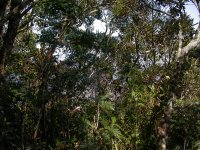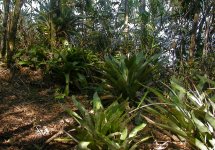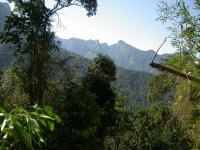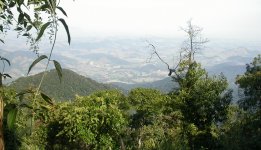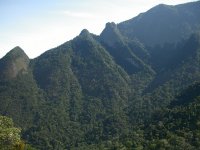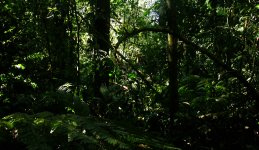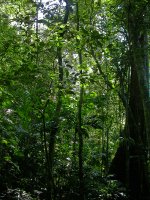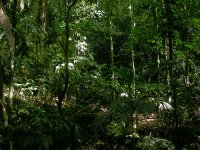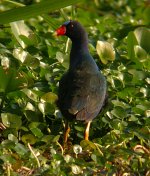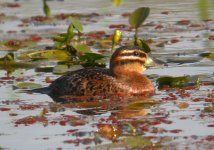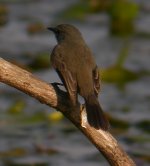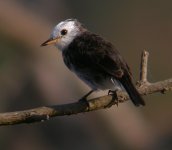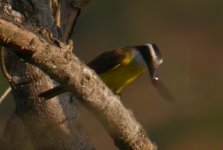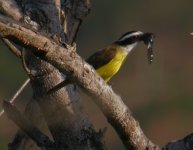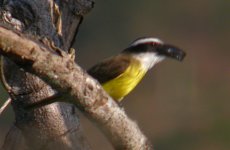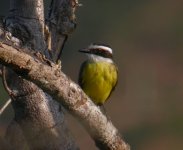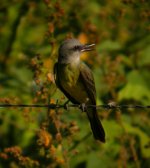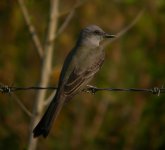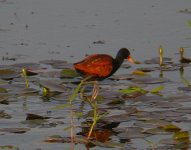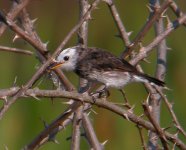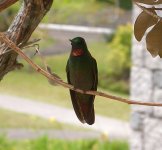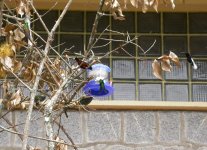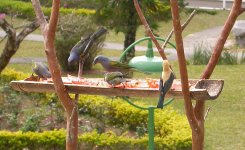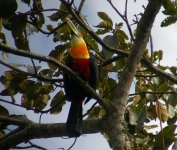-
Welcome to BirdForum, the internet's largest birding community with thousands of members from all over the world. The forums are dedicated to wild birds, birding, binoculars and equipment and all that goes with it.
Please register for an account to take part in the discussions in the forum, post your pictures in the gallery and more.
You are using an out of date browser. It may not display this or other websites correctly.
You should upgrade or use an alternative browser.
You should upgrade or use an alternative browser.
The Boy in Brazil: July-August 2006 (2 Viewers)
- Thread starter Andrew Whitehouse
- Start date
More options
Who Replied?
Swift said:We camped at the middle camp site and climbed up to see Grey-winged Cotinga about four years ago , did you pass the country club at the bottom on the road to Terrasopolis? That is where Ricardo Parrini (ace birder) refound the Kinglet Calyptura C. cristata he had two birds in October 1996 for two? days, I heard that this species has been seen recently in the Ubatuba area.
Hi Swift,
I passed the Kinglet Calyptura spot you mention but didn't stop there. The place where I saw Grey-winged Cotinga is quite a long way from there, near to Nova Friburgo. I think there's a thread somewhere on here about the Kinglet Calyptura at Ubatuba.

Alf King said:Is this report now complete Andrew?
I've found it to be both very interesting and informative so far.
Alf King
It's still very much a 'work in progress'. I actually have another week or so to write up, which I'll try and do one day before I forget everything! Glad you've enjoyed it so far Alf.
JWN Andrewes
Poor Judge of Pasta.
No, no, stop! It just makes me want to go back and I can't afford it! I can't take any more! (Oh, go on then, as you've started!)
James
ps - Spot-backed Antshrikes rock, yes?
James
ps - Spot-backed Antshrikes rock, yes?

Day Fourteen: 25th July
Something I forgot to mention from Day Twelve was that at dusk I saw a couple of Capybara on the wetlands, munching through the wet grass like small cows.
Anyway, in an unusual move, here's some more.
Today was rather epic, at least in terms of scenery and effort: five of us were walking up the Waterfall Trail and continuing on up the mountain to the elfin forest at the top. Deep breath. After being dropped off at the cottage, where once again a Glittering-throated Emerald was at the feeders, we headed up the trail at brisker pace than yesterday. Not for the first time on the trip, a Slaty Bristlefront was heard calling from a long way inside some very thick bamboo cover. Another source of noise proved easier to locate, as a couple of Blond-crested Woodpeckers gave good views but, once again, there was no sign of Shrike-like Cotinga in the regular spot.
We stormed on upwards, seeing some good flocks of tanagers including, rather briefly, my first Rufous-headed Tanager amongst the Yellow-backed and Olive-green Tanagers. A couple of Azure-shouldered Tanagers and Yellow-eared and Yellow-throated Woodpeckers were also in the forest. A sharp clanging came from a Bare-throated Bellbird but would it be possible to see it? I’d heard a few previously but the sound was always coming from too far into the forest. This time was different; a Bellbird was perched right out on an open branch across a clearing, loudly tonking away. Because we were looking into the light, the views weren’t perfect but it was brilliant to see such a legendary bird living up to its name.
http://www.xeno-canto.org/sounds/uploaded/BCWZQTGMSO/bathbellbir.mp3
On we continued, beyond the Waterfall Trail and up the steep Red Trail, through ever wilder forest. Birds were hard to see, but the shrill cries of parrots and the buzzing chirps of Uniform Finches kept us company. A Channel-billed Toucan sailed briefly into the tree tops and a Sharpbill was heard calling and was seen briefly by Lee. I was unable to get onto it in time, as was becoming a habit. The occasional fallen tree produced clearings that held some interesting birds. A sooty black flycatcher puzzled all of us for a while and it wasn’t until we got back to the lodge later that we finally resolved that it had been a Tropical Pewee. It was much darker than the illustrations in any of the guides but apparently the subspecies found in southeast Brazil is almost entirely dark. At another clearing, quite a few birds were moving through, including some obliging Ferruginous Antbirds – the first I’d seen since Serra dos Tucanos.
The path got steeper and steeper and we sometimes had to clamber under fallen branches to make our way through. Eventually we found ourselves on the flat top of the mountain in forest that looked totally different to that through which we’d passed. The trees were small, the canopy open and sturdy bromeliads carpeted the ground. The only birds at the top were a pair of very visible and curious Greyish Mourners, which followed us about as we admired the views out across the valley to the Serra dos Orgaos beyond and then down to the deforested lowlands stretching towards the coast.
Scrambling down the hill, we all struggled to keep up with Adilei, who stopped to point out a calling White-bibbed Antbird. We rested at the junction of the Lost Trail (so named because a couple visitors had once got lost there and spent the night out in the forest!) and were able to catch sight of a large woodcreeper off through the trees. The pale bill and rather plain head markings identified this as a Buff-throated Woodcreeper – the only one of the trip. As we rested, we heard movement in the leaf litter. Getting closer. Craning our necks over the small ridge, eventually the source became visible: a Tawny-throated Leaftosser, picking and rustling about in its Blackbird-like fashion. After continuing on to the bottom of the Lost Trail we got picked up at the 4x4 Trail and were driven back across the fields to the lodge.
In the last hour or so of light, I wandered over to the wetlands and found Nicholas running back to the office to pick up his scope because he wanted to have a better look at the parrots coming into roost in one of the dense stands of bamboo. When I arrived there was just one Blue-winged Macaw still showing, together with another large parrot, which we weren’t sure about at first but later we figured it out was an Orange-winged Parrot. By the time Nicholas came back, a scope and tripod trailing from the back of his bike, the parrots had gone into roost and out of sight.
The birding hadn’t finished with nightfall. After dinner, the others started to make their way down the hill from the lodge but we soon realised that owls were about, and they were making as strange a sound as I’ve ever heard from a bird. A Tawny-browed Owl was in the trees by the lodge garden, giving a call almost like Rolf Harris on his wobble-board. But much stranger:
http://www.xeno-canto.org/sounds/uploaded/YRDADNREOP/Pulsatrix_koeniswaldiaena.mp3
We got hold of the flashlight, which had been on charge but was still very low on juice. Lee panned it around the trees and I just had time for a quick view of an owl before the charge went and so in turn did the light.
Below are two shots of the elfin forest and three views from the top of the mountain.
Something I forgot to mention from Day Twelve was that at dusk I saw a couple of Capybara on the wetlands, munching through the wet grass like small cows.
Anyway, in an unusual move, here's some more.
Today was rather epic, at least in terms of scenery and effort: five of us were walking up the Waterfall Trail and continuing on up the mountain to the elfin forest at the top. Deep breath. After being dropped off at the cottage, where once again a Glittering-throated Emerald was at the feeders, we headed up the trail at brisker pace than yesterday. Not for the first time on the trip, a Slaty Bristlefront was heard calling from a long way inside some very thick bamboo cover. Another source of noise proved easier to locate, as a couple of Blond-crested Woodpeckers gave good views but, once again, there was no sign of Shrike-like Cotinga in the regular spot.
We stormed on upwards, seeing some good flocks of tanagers including, rather briefly, my first Rufous-headed Tanager amongst the Yellow-backed and Olive-green Tanagers. A couple of Azure-shouldered Tanagers and Yellow-eared and Yellow-throated Woodpeckers were also in the forest. A sharp clanging came from a Bare-throated Bellbird but would it be possible to see it? I’d heard a few previously but the sound was always coming from too far into the forest. This time was different; a Bellbird was perched right out on an open branch across a clearing, loudly tonking away. Because we were looking into the light, the views weren’t perfect but it was brilliant to see such a legendary bird living up to its name.
http://www.xeno-canto.org/sounds/uploaded/BCWZQTGMSO/bathbellbir.mp3
On we continued, beyond the Waterfall Trail and up the steep Red Trail, through ever wilder forest. Birds were hard to see, but the shrill cries of parrots and the buzzing chirps of Uniform Finches kept us company. A Channel-billed Toucan sailed briefly into the tree tops and a Sharpbill was heard calling and was seen briefly by Lee. I was unable to get onto it in time, as was becoming a habit. The occasional fallen tree produced clearings that held some interesting birds. A sooty black flycatcher puzzled all of us for a while and it wasn’t until we got back to the lodge later that we finally resolved that it had been a Tropical Pewee. It was much darker than the illustrations in any of the guides but apparently the subspecies found in southeast Brazil is almost entirely dark. At another clearing, quite a few birds were moving through, including some obliging Ferruginous Antbirds – the first I’d seen since Serra dos Tucanos.
The path got steeper and steeper and we sometimes had to clamber under fallen branches to make our way through. Eventually we found ourselves on the flat top of the mountain in forest that looked totally different to that through which we’d passed. The trees were small, the canopy open and sturdy bromeliads carpeted the ground. The only birds at the top were a pair of very visible and curious Greyish Mourners, which followed us about as we admired the views out across the valley to the Serra dos Orgaos beyond and then down to the deforested lowlands stretching towards the coast.
Scrambling down the hill, we all struggled to keep up with Adilei, who stopped to point out a calling White-bibbed Antbird. We rested at the junction of the Lost Trail (so named because a couple visitors had once got lost there and spent the night out in the forest!) and were able to catch sight of a large woodcreeper off through the trees. The pale bill and rather plain head markings identified this as a Buff-throated Woodcreeper – the only one of the trip. As we rested, we heard movement in the leaf litter. Getting closer. Craning our necks over the small ridge, eventually the source became visible: a Tawny-throated Leaftosser, picking and rustling about in its Blackbird-like fashion. After continuing on to the bottom of the Lost Trail we got picked up at the 4x4 Trail and were driven back across the fields to the lodge.
In the last hour or so of light, I wandered over to the wetlands and found Nicholas running back to the office to pick up his scope because he wanted to have a better look at the parrots coming into roost in one of the dense stands of bamboo. When I arrived there was just one Blue-winged Macaw still showing, together with another large parrot, which we weren’t sure about at first but later we figured it out was an Orange-winged Parrot. By the time Nicholas came back, a scope and tripod trailing from the back of his bike, the parrots had gone into roost and out of sight.
The birding hadn’t finished with nightfall. After dinner, the others started to make their way down the hill from the lodge but we soon realised that owls were about, and they were making as strange a sound as I’ve ever heard from a bird. A Tawny-browed Owl was in the trees by the lodge garden, giving a call almost like Rolf Harris on his wobble-board. But much stranger:
http://www.xeno-canto.org/sounds/uploaded/YRDADNREOP/Pulsatrix_koeniswaldiaena.mp3
We got hold of the flashlight, which had been on charge but was still very low on juice. Lee panned it around the trees and I just had time for a quick view of an owl before the charge went and so in turn did the light.
Below are two shots of the elfin forest and three views from the top of the mountain.
Attachments


Day Fifteen: 26th July
Today was my last full day at REGUA and I decided to have a fairly easy time birding and taking pictures around the lodge.
In the morning, I set off on the trail back to where I had seen Tufted Antshrike a few days previously. I could hear the bird again but it was calling from across the valley – probably out of range even if I was using playback to bring it in. In the same area I was once again able to get great views of Moustached Wrens, the pair again very active in the low scrub at the side of the path.
The forest around the lodge was a bit quiet at times but I was delighted to get great views of a brilliant Rufous-tailed Jacamar as it perched like a sentry under the canopy. I’d not used a great deal of tape playback on this trip but I wanted to get better views than I’d had of Sooretama Slaty-antshrike so I stopped in what I thought might be a good spot (although I’m still not sure why) and got out the player and the speakers. Within a few seconds I had a pair of these scarce endemics hopping about within a few metres, giving good enough views to see the features distinguishing both male and female from the commoner Variable Antshrike. Very fine birds.
The wetlands had the usual assortment of herons, ducks and kingfishers but the highlight soon appeared in the large dead tree near the tower. This was a medium-sized, dark grey raptor with a rather long curved hook to the bill and bright red legs. After noticing the white uppertail I figured out that I was looking at a Snail Kite. It gave a great show, drifting lazily over the wetland before disappearing. Although these are common in some places, this was quite a good sighting for REGUA.
After lunch, on what was another very warm and sunny day, I decided on a gentle wander around the wetlands trying to get some bird pictures. I just had my ED50 and digital camera with me, but conditions were pretty good and I was able to get some nice shots of Tropical Kingbird, White-headed Marsh Tyrant, American Purple Gallinule and a very cooperative female Masked Duck. I also got a few shots of a Great Kiskadee with a very large tadpole it had caught. I had a quick look around the forested hill overlooking the main lake, and got a surprise when a Pauraque shot from the side of the path and whizzed out of sight. Not a great view but my first Nightjar of the trip.
As dusk closed in on the wetlands, I again disturbed the Limpkin from the marshy vegetation near the tower and then I watched some large groups of blackbirds coming into roost. Most were Chestnut-capped Blackbirds but there were also plenty of glossy looking Shiny Cowbirds. A group of buff, grey and pink White-tipped Doves came into a small stand of trees and I had some good views of three Common Thornbirds, hanging around their huge stick nests.
In the evening, there was a party at the volunteers’ residence. Andy and Cristina from Serra dos Tucanos had come over and it was good to catch up with them and sample some excellent home made cakes. Outside, the Tawny-browed Owls were on good form and two of us headed back up to the lodge, this time with a fully charged light, to try and get some views. Soon we could see one bird really well, looking big in the trees by the garden as it sent out its unnerving shimmering call.
A few pictures taken in the afternoon:
American Purple Gallinule (first two), Masked Duck, Sooty Tyrannulet, White-headed Marsh Tyrant
Today was my last full day at REGUA and I decided to have a fairly easy time birding and taking pictures around the lodge.
In the morning, I set off on the trail back to where I had seen Tufted Antshrike a few days previously. I could hear the bird again but it was calling from across the valley – probably out of range even if I was using playback to bring it in. In the same area I was once again able to get great views of Moustached Wrens, the pair again very active in the low scrub at the side of the path.
The forest around the lodge was a bit quiet at times but I was delighted to get great views of a brilliant Rufous-tailed Jacamar as it perched like a sentry under the canopy. I’d not used a great deal of tape playback on this trip but I wanted to get better views than I’d had of Sooretama Slaty-antshrike so I stopped in what I thought might be a good spot (although I’m still not sure why) and got out the player and the speakers. Within a few seconds I had a pair of these scarce endemics hopping about within a few metres, giving good enough views to see the features distinguishing both male and female from the commoner Variable Antshrike. Very fine birds.
The wetlands had the usual assortment of herons, ducks and kingfishers but the highlight soon appeared in the large dead tree near the tower. This was a medium-sized, dark grey raptor with a rather long curved hook to the bill and bright red legs. After noticing the white uppertail I figured out that I was looking at a Snail Kite. It gave a great show, drifting lazily over the wetland before disappearing. Although these are common in some places, this was quite a good sighting for REGUA.
After lunch, on what was another very warm and sunny day, I decided on a gentle wander around the wetlands trying to get some bird pictures. I just had my ED50 and digital camera with me, but conditions were pretty good and I was able to get some nice shots of Tropical Kingbird, White-headed Marsh Tyrant, American Purple Gallinule and a very cooperative female Masked Duck. I also got a few shots of a Great Kiskadee with a very large tadpole it had caught. I had a quick look around the forested hill overlooking the main lake, and got a surprise when a Pauraque shot from the side of the path and whizzed out of sight. Not a great view but my first Nightjar of the trip.
As dusk closed in on the wetlands, I again disturbed the Limpkin from the marshy vegetation near the tower and then I watched some large groups of blackbirds coming into roost. Most were Chestnut-capped Blackbirds but there were also plenty of glossy looking Shiny Cowbirds. A group of buff, grey and pink White-tipped Doves came into a small stand of trees and I had some good views of three Common Thornbirds, hanging around their huge stick nests.
In the evening, there was a party at the volunteers’ residence. Andy and Cristina from Serra dos Tucanos had come over and it was good to catch up with them and sample some excellent home made cakes. Outside, the Tawny-browed Owls were on good form and two of us headed back up to the lodge, this time with a fully charged light, to try and get some views. Soon we could see one bird really well, looking big in the trees by the garden as it sent out its unnerving shimmering call.
A few pictures taken in the afternoon:
American Purple Gallinule (first two), Masked Duck, Sooty Tyrannulet, White-headed Marsh Tyrant
Attachments


A few more shots: Chestnut-capped Blackbird, Tropical Kingbird (two pictures), Wattled Jacana, White-headed Marsh Tyrant.
Attachments

Day Sixteen: 27th July
I was woken on my final morning at REGUA by some noisy parrots in the garden. These proved to be a pair of Orange-winged Parrots, giving some fine views as they squawked in the trees.
I only had time for a short walk around the wetlands and the forest but managed one new bird: a Reddish Hermit, small and rusty looking, that dashed past me. Otherwise I enjoyed some final views of a few good REGUA species, including Lesser Yellow-headed Vulture and White-flanked and Unicoloured Antwrens.
Soon I was back at the lodge, saying my goodbyes and getting in the car with Nicholas on my way to catch a bus into Rio from Cachoieras de Macacu. We had a bite to eat and Nicholas was able to book me a few nights at my next destination: the Hotel Donati in Itatiaia National Park.
Eventually the bus arrived and I had a fairly uneventful journey into Rio. The bus station was very busy but seemed a fairly safe place, with lots of intimidating looking security guards around. There are huge numbers of different companies serving all parts of the country but I managed to find the right ticket office for buses to Itatiaia
I took the bus as far as Resende, just a few miles from Itatiaia town. After a bit of help, I got onto a small minibus going to Itatiaia. The town was a bit bigger than I thought (I was expecting a village!) and I wasn’t sure where to get off. Eventually, the folks driving the bus figured out I probably wanted to find a taxi, so dropped me off near to a taxi rank in the centre of town. I asked the driver to take me to the Hotel Donati and, as darkness fell, we were soon on our way up the hill to the park entrance. The fare was pretty reasonable (only about five pounds) and I was able to get settled into my cabin at the hotel and enjoy one of many excellent buffet meals. Itatiaia proved to be a very fine place for birding.
I was woken on my final morning at REGUA by some noisy parrots in the garden. These proved to be a pair of Orange-winged Parrots, giving some fine views as they squawked in the trees.
I only had time for a short walk around the wetlands and the forest but managed one new bird: a Reddish Hermit, small and rusty looking, that dashed past me. Otherwise I enjoyed some final views of a few good REGUA species, including Lesser Yellow-headed Vulture and White-flanked and Unicoloured Antwrens.
Soon I was back at the lodge, saying my goodbyes and getting in the car with Nicholas on my way to catch a bus into Rio from Cachoieras de Macacu. We had a bite to eat and Nicholas was able to book me a few nights at my next destination: the Hotel Donati in Itatiaia National Park.
Eventually the bus arrived and I had a fairly uneventful journey into Rio. The bus station was very busy but seemed a fairly safe place, with lots of intimidating looking security guards around. There are huge numbers of different companies serving all parts of the country but I managed to find the right ticket office for buses to Itatiaia
I took the bus as far as Resende, just a few miles from Itatiaia town. After a bit of help, I got onto a small minibus going to Itatiaia. The town was a bit bigger than I thought (I was expecting a village!) and I wasn’t sure where to get off. Eventually, the folks driving the bus figured out I probably wanted to find a taxi, so dropped me off near to a taxi rank in the centre of town. I asked the driver to take me to the Hotel Donati and, as darkness fell, we were soon on our way up the hill to the park entrance. The fare was pretty reasonable (only about five pounds) and I was able to get settled into my cabin at the hotel and enjoy one of many excellent buffet meals. Itatiaia proved to be a very fine place for birding.

Thank you Andrew - the begging and pleading worked then 
I'm looking forward to the next episode
Happy New YearB
D
I'm looking forward to the next episode
Happy New YearB
D

Day Seventeen: 28th July
The grounds at the Hotel Donati consist of a fairly open area of lawns and gardens, with some tall trees. The hotel is surrounded by varied forest, including some quite dense stands of bamboo. The birds that were most immediately apparent were the strutting Dusky-legged Guans that strode confidently about the lawns and even perched up in the trees. They’re shy in most parts of their range but several decades of protection in Itatiaia have emboldened them considerably. I soon noticed the rather hefty looking Magpie Tanagers flitting about the gardens – a species that had eluded me elsewhere but proved to be easy to see around the hotels in the park. A flock of diminutive, soft-green Blue-winged Parrotlets were enjoying use of the lawn before the human residents took over. In the tall trees next to me chalet, I was pleased to see a noisy Suruca Trogon.
I took a wander along the tall avenue of trees lining the hotel driveway and soon noticed two large birds fly into the canopy. Through the early morning gloom, I was astonished to see that these were a pair of Robust Woodpeckers – one of the birds I was keenest to see in Brazil and one of the closest relatives of the now extinct Ivory-billed Woodpecker. During the morning I was able to get some wonderful views of these magnificent crimson-headed birds, with their jet black bodies and creamy backs, in the grounds of the hotel. The big woodpecker action wasn’t complete either, as an almost equally fine Lineated Woodpecker was climbing up a tree near to the entrance. This species is only slightly smaller than the Robust, with neatly barred underparts. And just to round things off, I noticed a White-spotted Woodpecker clambering about in a small tree. Although undeniably a less spectacular species, it was a good one to get – a medium-sized woody, with barred mossy-green and white plumage.
There was plenty of other activity around the grounds. Several large moths had been attracted to the lights around the entrance, some looking rather like Oak Eggars, and these drew the attention of a voracious Grey-hooded Attila, which set about demolishing them with abandon. Better still was a delicate green barred passerine sat at the top of a tree – a female Swallow Tanager.
In a bid to work off the substantial hotel breakfast, I set off through the bamboo forest and towards the Hotel Simon. The bamboo was lively with some excellent mixed flocks moving about. I could scarcely have been more delighted when a big woodcreeper turned out to be my second jaw-droppingly wonderful Black-billed Scythebill of the trip. The bill of these birds is a thing to behold. There were plenty of White-collared Foliage-gleaners and a good few White-shouldered Fire-eyes, which were much easier to see here than they’d been elsewhere. Further on, I enjoyed my best views yet of Black-throated Grosbeak, a hefty tar black finch with a salmon pink bill. Some Diademed Tanagers – perhaps my favourite tanagers of the trip – were in a more open area of forest.
The grounds of the Hotel Simon seemed less obviously birdy than the Donati, but I knew that the feeders here had a reputation for excellence. Initially I was disappointed to see very few birds were coming in, and so I took a wander around the small garden at the rear of the hotel. Bossing the place were two vivid yellow and very showy Saffron Toucanets. A few hummers were coming into one of the flowering shrubs and it was here that I saw one of my favourite birds of the trip: a glorious Black-eared Fairy. This isn’t an especially gaudy hummingbird but it has the most startling contrast between deepest green upperparts and gleaming white underparts and outer tail feather. This is all set off by the dark purple ear coverts from whence its name is derived. The word exquisite fits no bird better and this one put on a wonderful show, flitting from flower to flower and perching up in the branches.
Around the front, I discovered the hotel staff filling up the feeders with bananas and sugar solution. This had a predictably transformative effect and soon the tanagers were piling into the fruit, mostly Golden-chevroned Tanagers but also the occasional Burnished Buff. Several species of hummer were fizzing about the newly replenished feeders: Black Jacobin, Brazilian Ruby, Violet-capped Woodnymph and a rather dowdy Versicoloured Emerald. I got invited up onto the balcony by one of the staff and got to take some pictures as the birds fed just a few metres in front.
I embarked on a circuitous walk back to the Hotel Donati, along some of the forest roads. Early on, I took a wrong turn into someone’s garden and, much to my delight, found two Slaty-breasted Woodrails, strutting away from me. This was a bird I’d heard many times, seen the back end of, and probably glimpsed in the dark, but here were a pair happily wandering about in the open in the middle of the day – big, grey and rufous rails, with long yellow bills. A gleaming Gilt-edged Tanager, all on its own, was a surprise at the roadside. One of the most impressive birds of the day was a splendid Red-breasted Toucan sat at the top of a tree. This prompted my first, and so far only, foray into digibinning – with fairly successful results.
Earlier in the day, I’d glimpsed a large crow-like bird drifting through the trees near the hotel and discussions with some visiting birders I met began to lead me to certain conclusions about what bird this had been. As I approached the same area on my return to the hotel, I managed a much better view of the bird in question, albeit through a maze of trees. It was a fantastic Red-ruffed Fruitcrow, a bird that really does look like a crow but with a vivid red throat. These are shy birds but I saw at least three moving darkly about the forests near the hotel entrance.
After a late lunch I took a wander along a trail going through some very thick bamboo forest. Birds were hard to see here but I managed a real surprise in the shape of a White-bellied Warbler. This species is very similar to the much commoner Golden-crowned Warbler but is white rather than yellow below. It’s also much less common. Walking back along a forest road, I had some decent views of another Rufous-capped Motmot. Further on, I had an interesting but slightly frustrating encounter. The light had turned very gloomy in the bamboo forest when I saw a small bird running along the trail ahead of me. I realised it was one of the Chamaeza Antthrushes, but which one? These are all rather similar looking and the three possible species are best distinguished by voice and altitude. I hoped I could get some closer views of it but it kept running on ahead of me as it methodically wandered along the path. I had the odd experience of scampering after a bird for a good few hundred yards. I got a bit closer but the light was too gloomy to pick out much detail and eventually it flitted off the path and out of sight. I suspected, on altitude, that it was the rare endemic Such’s Antthrush but I’d have to wait till tomorrow to see if I could find it again.
The grounds at the Hotel Donati consist of a fairly open area of lawns and gardens, with some tall trees. The hotel is surrounded by varied forest, including some quite dense stands of bamboo. The birds that were most immediately apparent were the strutting Dusky-legged Guans that strode confidently about the lawns and even perched up in the trees. They’re shy in most parts of their range but several decades of protection in Itatiaia have emboldened them considerably. I soon noticed the rather hefty looking Magpie Tanagers flitting about the gardens – a species that had eluded me elsewhere but proved to be easy to see around the hotels in the park. A flock of diminutive, soft-green Blue-winged Parrotlets were enjoying use of the lawn before the human residents took over. In the tall trees next to me chalet, I was pleased to see a noisy Suruca Trogon.
I took a wander along the tall avenue of trees lining the hotel driveway and soon noticed two large birds fly into the canopy. Through the early morning gloom, I was astonished to see that these were a pair of Robust Woodpeckers – one of the birds I was keenest to see in Brazil and one of the closest relatives of the now extinct Ivory-billed Woodpecker. During the morning I was able to get some wonderful views of these magnificent crimson-headed birds, with their jet black bodies and creamy backs, in the grounds of the hotel. The big woodpecker action wasn’t complete either, as an almost equally fine Lineated Woodpecker was climbing up a tree near to the entrance. This species is only slightly smaller than the Robust, with neatly barred underparts. And just to round things off, I noticed a White-spotted Woodpecker clambering about in a small tree. Although undeniably a less spectacular species, it was a good one to get – a medium-sized woody, with barred mossy-green and white plumage.
There was plenty of other activity around the grounds. Several large moths had been attracted to the lights around the entrance, some looking rather like Oak Eggars, and these drew the attention of a voracious Grey-hooded Attila, which set about demolishing them with abandon. Better still was a delicate green barred passerine sat at the top of a tree – a female Swallow Tanager.
In a bid to work off the substantial hotel breakfast, I set off through the bamboo forest and towards the Hotel Simon. The bamboo was lively with some excellent mixed flocks moving about. I could scarcely have been more delighted when a big woodcreeper turned out to be my second jaw-droppingly wonderful Black-billed Scythebill of the trip. The bill of these birds is a thing to behold. There were plenty of White-collared Foliage-gleaners and a good few White-shouldered Fire-eyes, which were much easier to see here than they’d been elsewhere. Further on, I enjoyed my best views yet of Black-throated Grosbeak, a hefty tar black finch with a salmon pink bill. Some Diademed Tanagers – perhaps my favourite tanagers of the trip – were in a more open area of forest.
The grounds of the Hotel Simon seemed less obviously birdy than the Donati, but I knew that the feeders here had a reputation for excellence. Initially I was disappointed to see very few birds were coming in, and so I took a wander around the small garden at the rear of the hotel. Bossing the place were two vivid yellow and very showy Saffron Toucanets. A few hummers were coming into one of the flowering shrubs and it was here that I saw one of my favourite birds of the trip: a glorious Black-eared Fairy. This isn’t an especially gaudy hummingbird but it has the most startling contrast between deepest green upperparts and gleaming white underparts and outer tail feather. This is all set off by the dark purple ear coverts from whence its name is derived. The word exquisite fits no bird better and this one put on a wonderful show, flitting from flower to flower and perching up in the branches.
Around the front, I discovered the hotel staff filling up the feeders with bananas and sugar solution. This had a predictably transformative effect and soon the tanagers were piling into the fruit, mostly Golden-chevroned Tanagers but also the occasional Burnished Buff. Several species of hummer were fizzing about the newly replenished feeders: Black Jacobin, Brazilian Ruby, Violet-capped Woodnymph and a rather dowdy Versicoloured Emerald. I got invited up onto the balcony by one of the staff and got to take some pictures as the birds fed just a few metres in front.
I embarked on a circuitous walk back to the Hotel Donati, along some of the forest roads. Early on, I took a wrong turn into someone’s garden and, much to my delight, found two Slaty-breasted Woodrails, strutting away from me. This was a bird I’d heard many times, seen the back end of, and probably glimpsed in the dark, but here were a pair happily wandering about in the open in the middle of the day – big, grey and rufous rails, with long yellow bills. A gleaming Gilt-edged Tanager, all on its own, was a surprise at the roadside. One of the most impressive birds of the day was a splendid Red-breasted Toucan sat at the top of a tree. This prompted my first, and so far only, foray into digibinning – with fairly successful results.
Earlier in the day, I’d glimpsed a large crow-like bird drifting through the trees near the hotel and discussions with some visiting birders I met began to lead me to certain conclusions about what bird this had been. As I approached the same area on my return to the hotel, I managed a much better view of the bird in question, albeit through a maze of trees. It was a fantastic Red-ruffed Fruitcrow, a bird that really does look like a crow but with a vivid red throat. These are shy birds but I saw at least three moving darkly about the forests near the hotel entrance.
After a late lunch I took a wander along a trail going through some very thick bamboo forest. Birds were hard to see here but I managed a real surprise in the shape of a White-bellied Warbler. This species is very similar to the much commoner Golden-crowned Warbler but is white rather than yellow below. It’s also much less common. Walking back along a forest road, I had some decent views of another Rufous-capped Motmot. Further on, I had an interesting but slightly frustrating encounter. The light had turned very gloomy in the bamboo forest when I saw a small bird running along the trail ahead of me. I realised it was one of the Chamaeza Antthrushes, but which one? These are all rather similar looking and the three possible species are best distinguished by voice and altitude. I hoped I could get some closer views of it but it kept running on ahead of me as it methodically wandered along the path. I had the odd experience of scampering after a bird for a good few hundred yards. I got a bit closer but the light was too gloomy to pick out much detail and eventually it flitted off the path and out of sight. I suspected, on altitude, that it was the rare endemic Such’s Antthrush but I’d have to wait till tomorrow to see if I could find it again.

Some pictures from the day:
Brazilian Ruby,
Hummingbird feeders at the Hotel Simon (l-r Brazilian Ruby, Golden-chevroned Tanagers x2, Chestnut-bellied Euphonia, Violet-capped Woodnymph, Black Jacobin),
Fruit feeders at the Hotel Simon (4 Golden-chevroned Tanagers and one Burnished-Buff Tanager,
Red-breasted Toucan
Brazilian Ruby,
Hummingbird feeders at the Hotel Simon (l-r Brazilian Ruby, Golden-chevroned Tanagers x2, Chestnut-bellied Euphonia, Violet-capped Woodnymph, Black Jacobin),
Fruit feeders at the Hotel Simon (4 Golden-chevroned Tanagers and one Burnished-Buff Tanager,
Red-breasted Toucan
Attachments
Hi Andrew
I'm so glad that you have continued with your story, I've been really enjoying your adventures. The pictures are great, make me quite jealous and I'm now going to have to start saving for my trip out there. The native language is Portugese isn't it? Might have to find a night school class.
I'm so glad that you have continued with your story, I've been really enjoying your adventures. The pictures are great, make me quite jealous and I'm now going to have to start saving for my trip out there. The native language is Portugese isn't it? Might have to find a night school class.

Glad you're enjoying it Keith. Portuguese is the language, of which I acquired embarrasingly little. I think if you were to spend more time away from tourist areas and eco-lodges, you'll certainly find a basic command of the language very handy though.
Last edited:

Bump  :-O
:-O
D
D

Hmm, interesting suggestion! And now I've got another trip report to do as well.

Day Eighteen: 29th July
In an unusual move, I thought I’d try to finish off this trip report. And hey, it’s a celebration of the first anniversary of the trip after all. Better late than never.
In the morning, I had a wander around the grounds of the Hotel Donati in somewhat cooler and cloudier conditions than I’d grown accustomed to. Again, I had good views of Robust Woodpecker – including one just thirty metres from my hotel room – Red-ruffed Fruitcrow and Swallow Tanager. The highlight was a quick but close view of a gorgeous Frilled Coquette, a tiny hummer with a brilliant tuft of orange on its head.
I headed off on the trail through the bamboo forest and reached the point where I’d seen the Antthrush the previous afternoon. I thought I’d start up my player with a few recordings to see what kind of response I got. A blast of Such’s Antthrush soon got an emphatic response with a bird singing fairly close by but never coming into view. When I tried other species, I met with mute silence. So it certainly seems as if the Antthrush I’d seen the day before would have been Such’s, at least on circumstance (which is apparently a pretty good guide in southeast Brazil).
I spent much of the rest of the morning walking along a rather narrow trail that ran northwards through some dense forest, mostly of bamboo. Birds were generally a bit thin on the ground but I enjoyed good views of a Green-barred Woodpecker and also saw a Yellow Tyrannulet.
In the afternoon, I headed over to the Hotel Simon, hoping for more hummers. Things were rather quiet at the feeders so I wandered along the trail towards the Hotel do Ype. Immediately I encountered a good feeding flock and in amongst the other birds was a small pinkish coloured passerine with a distinct black cap. This was, rather unexpectedly, a Black-capped Piprites – a scarce high-altitude endemic and a bird I didn’t really expect to see this low down. I had good views of a Surucua Trogon as I walked along the trail and eventually found myself at the distinctive A-frame chalets of the Hotel do Ype. The feeders here were quite busy and, most notably, attracted two very smart Yellow-fronted Woodpeckers. That meant I’d seen four species of woodpecker in hotel grounds in Itatiaia that I never saw anywhere else.
On the way back, I encountered the unusual phenomenon of rain – the first of the trip. I also managed to almost knock myself out on a low bamboo trunk but survived for another substantial dinner I’m pleased to say.
In an unusual move, I thought I’d try to finish off this trip report. And hey, it’s a celebration of the first anniversary of the trip after all. Better late than never.
In the morning, I had a wander around the grounds of the Hotel Donati in somewhat cooler and cloudier conditions than I’d grown accustomed to. Again, I had good views of Robust Woodpecker – including one just thirty metres from my hotel room – Red-ruffed Fruitcrow and Swallow Tanager. The highlight was a quick but close view of a gorgeous Frilled Coquette, a tiny hummer with a brilliant tuft of orange on its head.
I headed off on the trail through the bamboo forest and reached the point where I’d seen the Antthrush the previous afternoon. I thought I’d start up my player with a few recordings to see what kind of response I got. A blast of Such’s Antthrush soon got an emphatic response with a bird singing fairly close by but never coming into view. When I tried other species, I met with mute silence. So it certainly seems as if the Antthrush I’d seen the day before would have been Such’s, at least on circumstance (which is apparently a pretty good guide in southeast Brazil).
I spent much of the rest of the morning walking along a rather narrow trail that ran northwards through some dense forest, mostly of bamboo. Birds were generally a bit thin on the ground but I enjoyed good views of a Green-barred Woodpecker and also saw a Yellow Tyrannulet.
In the afternoon, I headed over to the Hotel Simon, hoping for more hummers. Things were rather quiet at the feeders so I wandered along the trail towards the Hotel do Ype. Immediately I encountered a good feeding flock and in amongst the other birds was a small pinkish coloured passerine with a distinct black cap. This was, rather unexpectedly, a Black-capped Piprites – a scarce high-altitude endemic and a bird I didn’t really expect to see this low down. I had good views of a Surucua Trogon as I walked along the trail and eventually found myself at the distinctive A-frame chalets of the Hotel do Ype. The feeders here were quite busy and, most notably, attracted two very smart Yellow-fronted Woodpeckers. That meant I’d seen four species of woodpecker in hotel grounds in Itatiaia that I never saw anywhere else.
On the way back, I encountered the unusual phenomenon of rain – the first of the trip. I also managed to almost knock myself out on a low bamboo trunk but survived for another substantial dinner I’m pleased to say.
Similar threads
- Replies
- 0
- Views
- 592
- Replies
- 22
- Views
- 2K
Users who are viewing this thread
Total: 3 (members: 0, guests: 3)





